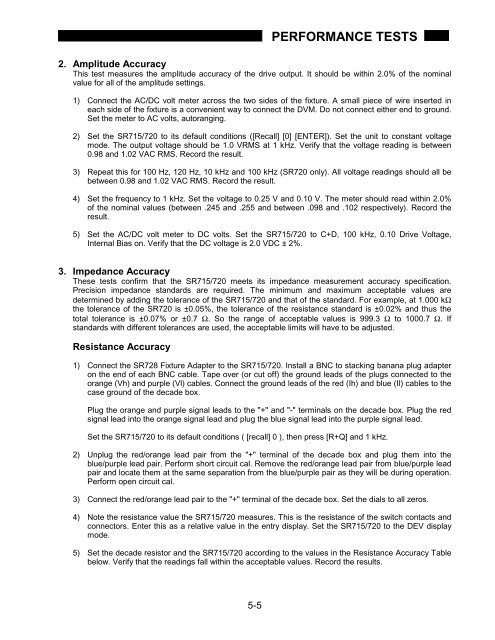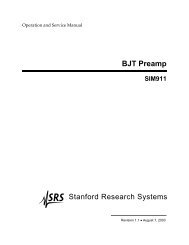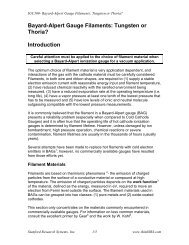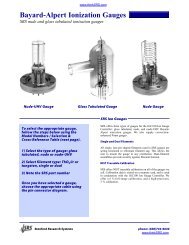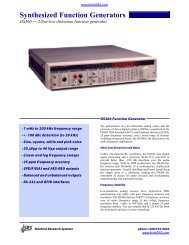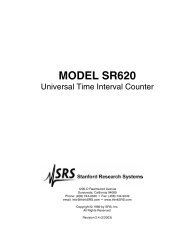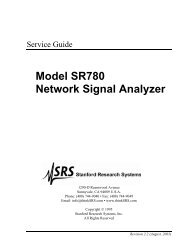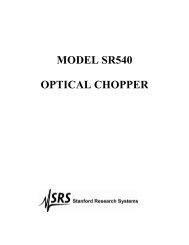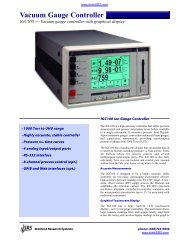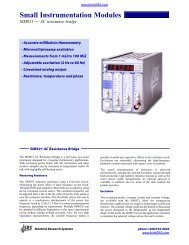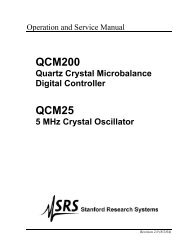Model SR715 Model SR720 LCR Meters
Model SR715 Model SR720 LCR Meters
Model SR715 Model SR720 LCR Meters
- No tags were found...
You also want an ePaper? Increase the reach of your titles
YUMPU automatically turns print PDFs into web optimized ePapers that Google loves.
PERFORMANCE TESTS2. Amplitude AccuracyThis test measures the amplitude accuracy of the drive output. It should be within 2.0% of the nominalvalue for all of the amplitude settings.1) Connect the AC/DC volt meter across the two sides of the fixture. A small piece of wire inserted ineach side of the fixture is a convenient way to connect the DVM. Do not connect either end to ground.Set the meter to AC volts, autoranging.2) Set the <strong>SR715</strong>/720 to its default conditions ([Recall] [0] [ENTER]). Set the unit to constant voltagemode. The output voltage should be 1.0 VRMS at 1 kHz. Verify that the voltage reading is between0.98 and 1.02 VAC RMS. Record the result.3) Repeat this for 100 Hz, 120 Hz, 10 kHz and 100 kHz (<strong>SR720</strong> only). All voltage readings should all bebetween 0.98 and 1.02 VAC RMS. Record the result.4) Set the frequency to 1 kHz. Set the voltage to 0.25 V and 0.10 V. The meter should read within 2.0%of the nominal values (between .245 and .255 and between .098 and .102 respectively). Record theresult.5) Set the AC/DC volt meter to DC volts. Set the <strong>SR715</strong>/720 to C+D, 100 kHz, 0.10 Drive Voltage,Internal Bias on. Verify that the DC voltage is 2.0 VDC ± 2%.3. Impedance AccuracyThese tests confirm that the <strong>SR715</strong>/720 meets its impedance measurement accuracy specification.Precision impedance standards are required. The minimum and maximum acceptable values aredetermined by adding the tolerance of the <strong>SR715</strong>/720 and that of the standard. For example, at 1.000 kΩthe tolerance of the <strong>SR720</strong> is ±0.05%, the tolerance of the resistance standard is ±0.02% and thus thetotal tolerance is ±0.07% or ±0.7 Ω. So the range of acceptable values is 999.3 Ω to 1000.7 Ω. Ifstandards with different tolerances are used, the acceptable limits will have to be adjusted.Resistance Accuracy1) Connect the SR728 Fixture Adapter to the <strong>SR715</strong>/720. Install a BNC to stacking banana plug adapteron the end of each BNC cable. Tape over (or cut off) the ground leads of the plugs connected to theorange (Vh) and purple (Vl) cables. Connect the ground leads of the red (Ih) and blue (Il) cables to thecase ground of the decade box.Plug the orange and purple signal leads to the "+" and "-" terminals on the decade box. Plug the redsignal lead into the orange signal lead and plug the blue signal lead into the purple signal lead.Set the <strong>SR715</strong>/720 to its default conditions ( [recall] 0 ), then press [R+Q] and 1 kHz.2) Unplug the red/orange lead pair from the "+" terminal of the decade box and plug them into theblue/purple lead pair. Perform short circuit cal. Remove the red/orange lead pair from blue/purple leadpair and locate them at the same separation from the blue/purple pair as they will be during operation.Perform open circuit cal.3) Connect the red/orange lead pair to the "+" terminal of the decade box. Set the dials to all zeros.4) Note the resistance value the <strong>SR715</strong>/720 measures. This is the resistance of the switch contacts andconnectors. Enter this as a relative value in the entry display. Set the <strong>SR715</strong>/720 to the DEV displaymode.5) Set the decade resistor and the <strong>SR715</strong>/720 according to the values in the Resistance Accuracy Tablebelow. Verify that the readings fall within the acceptable values. Record the results.5-5


